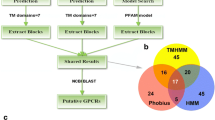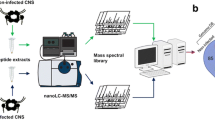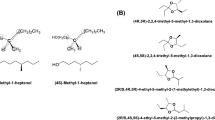Abstract
The freshwater snail Biomphalaria glabrata has drawn much research interest by virtue of it being one of the intermediate hosts of the parasitic flatworm Schistosoma mansoni, a causative agent of human schistosomiasis. Schistosomiasis is a chronic disease that affects over 260 million people globally, particularly in tropical and sub-tropical regions. One strategy that has been proposed as a way to prevent human infection by the parasite, involves the use of pheromone traps to lure the snail host away from areas of human activity. This requires an understanding of chemosensory communication in B. glabrata, especially of the chemoattractive factors. Although evidence indicates that specific chemical communication takes place, little is known about chemoattractants produced by the snail itself. Here, we report on the functional characterization of an endogenously produced temptin-like protein (BgTemptin) from B. glabrata and demonstrate that recombinant BgTemptin is attractive to this snail. Exposure of B. glabrata to BgTemptin results in 81% (lane maze) and 70% (T-maze) time spent near to the BgTemptin source. This effect, which is dependent on the concentration of the protein, provides another tool that can be further developed and used in efforts to control and eliminate schistosomiasis.





Similar content being viewed by others
References
Adema CM, Bayne CJ, Bridger JM, Knight M, Loker ES, Yoshino TP, Zhang S (2012) Will all scientists working on snails and the diseases they transmit please stand up? PLoS Negl Trop Dis 6(12):e1835
Adema CM, Hillier LW, Jones CS, Loker ES, Knight M, Minx P, Oliveira G, Raghavan N, Shedlock A, do Amaral LR, Arican-Goktas H, Assis JG, Baba EH, Baron OL, Bayne CJ, Bickham-Wright U, Biggar KK, Blouin M, Bonning BC, Botka C, Bridger JM, Buckley KM, Buddenborg SK, Lima Caldeira R, Carleton J, Carvalho OS, Castillo MG, Chalmers IW, Christensens M, Clifton S, Cosseau C, Coustau C, Cripps RM, Cuesta-Astroz Y, Cummins SF, di Stephano L, Dinguirard N, Duval D, Emrich S, Feschotte C, Feyereisen R, FitzGerald P, Fronick C, Fulton L, Galinier R, Gava SG, Geusz M, Geyer KK, Giraldo-Calderón GI, de SG, Gordy MA, Gourbal B, Grunau C, Hanington PC, Hoffmann KF, Hughes D, Humphries J, Jackson DJ, Jannotti-Passos L, De JJ, Jobling S, Kamel B, Kapusta A, Kaur S, Koene JM, Kohn AB, Lawson D, Lawton SP, Liang D, Limpanont Y, Liu S, Lockyer AE, Lovato TL, Ludolf F, Magrini V, McManus DP, Medina M, Misra M, Misra M, Mitta G, Mkoji GM, Montague MJ, Montelongo C, Moroz LL, Munoz-Torres M, Niazi U, Noble LR, Oliveira FS, Pais FS, Papenfuss AT, Peace R, Pena JJ, Pila EA, Quelais T, Raney BJ, Rast JP, Rollinson D, Rosse IC, Rotgans B, Routledge EJ, Ryan KM, Scholte LLS, Storey KB, Swain M, Tennessen JA, Tomlinson C, Trujillo DL, Volpi EV, Walker AJ, Wang T, Wannaporn I, Warren WC, Wu X, Yoshino TP, Yusuf M, Zhang S, Zhao M, Wilson RK (2017) Whole genome analysis of a schistosomiasis-transmitting freshwater snail. Nat Commun 8:15451. doi:10.1038/ncomms15451
Alborn HT, Turlings TCJ, Jones TH, Stenhagen G, Loughrin JH, Tumlinson JH (1997) An elicitor of plant volatiles from beet armyworm oral secretion. Science 276(5314):945–949
Alimenti C, Vallesi A, Federici S, Di Giuseppe G, Fernando D, Carratore V, Luporini P (2011) Isolation and structural characterization of two water-borne pheromones from Euplotes crassus, a ciliate commonly known to carry membrane-bound pheromones. J Eukaryot Microbiol 58(3):234–241
Baeza Garcia A, Pierce RJ, Gourbal B, Werkmeister E, Colinet D, Reichhart JM, Dissous C, Coustau C (2010) Involvement of the cytokine MIF in the snail host immune response to the parasite Schistosoma mansoni. PLoS Pathog 6(9):e1001115
Boal JG, Prosser KN, Holm JB, Simmons TL, Haas RE, Nagle GT (2010) Sexually mature cuttlefish are attracted to the eggs of conspecifics. J Chem Ecol 36(8):834–836
Bousfield JD, Gomm J, McCapra F, Thomas JD (1980) The molecular characteristics of chemoreception in the snail Biomphalaria glabrata (Say). J Appl Ecol 17(3):631–639
Brant CO, Li K, Johnson NS, Li W (2015) A pheromone outweighs temperature in influencing migration of sea lamprey. R Soc Open Sci 2(5):150009. doi:10.1098/rsos.150009
Bray RA, Jones A, Gibson DI (2002) Keys to the Trematoda. In: CABI Pub. and the Natural History Museum, Wallingford, New York
Browne KA, Tamburri MN, Zimmer-Faust R (1998) Modelling quantitative structure–activity relationships between animal behaviour and environmental signal molecules. J Exp Biol 201(2):245–258
Ceroni A, Passerini A, Vullo A, Frasconi P (2006) DISULFIND: a disulfide bonding state and cysteine connectivity prediction server. Nucleic Acids Res 34:W177–W181
Chauhan JS, Rao A, Raghava GPS (2013) In silico platform for prediction of N-, O- and C-glycosites in eukaryotic protein sequences. PLoS One 8(6):e67008
Cooper LA, Richards CS, Lewis FA, Minchella DJ (1994) Schistosoma mansoni: relationship between low fecundity and reduced susceptibility to parasite infection in the snail Biomphalaria glabrata. Exp Parasitol 79(1):21–28
Cooper LA, Larson SE, Lewis FA (1996) Male reproductive success of Schistosoma mansoni-infected Biomphalaria glabrata snails. J Parasitol 82(3):428–431
Cribb TH, Bray RA, Littlewood DT (2001) The nature and evolution of the association among digeneans, molluscs and fishes. Int J Parasitol 31(9):997–1011
Cummins SF, Bowie JH (2012) Pheromones, attractants and other chemical cues of aquatic organisms and amphibians. Nat Prod Rep 29(6):642–658
Cummins SF, Nichols AE, Amare A, Hummon AB, Sweedler JV, Nagle GT (2004) Characterization of Aplysia enticin and temptin, two novel water-borne protein pheromones that act in concert with attractin to stimulate mate attraction. J Biol Chem 279(24):25614–25622
Cummins SF, Nichols AE, Warso CJ, Nagle GT (2005) Aplysia seductin is a water-borne protein pheromone that acts in concert with attractin to stimulate mate attraction. Peptides 26:351–359
Cummins SF, Xie F, de Vries MR, Annangudi SP, Misra M, Degnan BM, Sweedler JV, Nagle GT, Schein CH (2007) Aplysia temptin—the ‘glue’ in the water-borne attractin pheromone complex. FEBS J 274:5425–5437
Cummins SF, Boal JG, Buresch KC, Kuanpradit C, Sobhon P, Holm JB, Degnan BM, Nagle GT, Hanlon RT (2011) Extreme aggression in male squid induced by a β-MSP-like pheromone. Curr Biol 21(4):322–327
Dunker AK, Kenyon AJ (1976) Mobility of sodium dodecyl sulphate–protein complexes. Biochem J 153(2):191–197
Erko B, Abebe F, Berhe N, Medhin G, Gebre-Michael T, Gemetchu T, Gundersen SG (2002) Control of Schistosoma mansoni by the soapberry Endod (Phytolacca dodecandra) in Wollo, northeastern Ethiopia: post-intervention prevalence. East Afr Med J 79(4):198–201
Esch GW, Barger MA, Fellis KJ (2002) The transmission of digenetic trematodes: style, elegance, complexity. Integr Comp Biol 42(2):304–312
Faro MJ, Perazzini M, Corrêa L, dos Reis Mello-Silva C, Pinheiro J, Mota EM, de Souza S, de Andrade Z, Júnior AM (2013) Biological, biochemical and histopathological features related to parasitic castration of Biomphalaria glabrata infected by Schistosoma mansoni. Exp Parasitol 134(2):228–234
Foster R, Teesdale C, Poulton GF (1959) Trials with a new molluscicide. Int J Pest Manag Part A 5(3):413–415
Galinier R, Portela J, Moné Y, Allienne JF, Henri H, Delbecq S, Mitta G, Gourbal B, Duval D (2013) Biomphalysin, a new β pore-forming toxin involved in Biomphalaria glabrata immune defense against Schistosoma mansoni. PLoS Pathog 9(3):e1003216
Gasteiger E, Gattiker A, Hoogland C, Ivanyi I, Appel RD, Bairoch A (2003) ExPASy: the proteomics server for in-depth protein knowledge and analysis. Nucleic Acids Res 31(13):3784–3788
Gaudron SM, Watson GJ, Bentley MG (2007) Induction of pairing in male scale worm Harmothoe imbricata (Polychaeta: Polynoidae) by chemical signals. J Mar Biol Assoc UK 87(5):1115–1116
Goodall CP, Bender RC, Brooks JK, Bayne CJ (2006) Biomphalaria glabrata cytosolic copper/zinc superoxide dismutase (SOD1) gene: association of SOD1 alleles with resistance/susceptibility to Schistosoma mansoni. Mol Biochem Parasitol 147(2):207–210
Gorbman A, Whiteley A, Kavanaugh S (2003) Pheromonal stimulation of spawning release of gametes by gonadotropin releasing hormone in the chiton, Mopalia sp. Gen Comp Endocrinol 131(1):62–65
Hanington PC, Forys MA, Loker ES (2012) A somatically diversified defense factor, FREP3, is a determinant of snail resistance to schistosome infection. PLoS Negl Trop Dis 6(3):e1591
Hathaway JJM, Adema CM, Stout BA, Mobarak CD, Loker ES (2010) Identification of protein components of egg masses indicates parental investment in immunoprotection of offspring by Biomphalaria glabrata (Gastropoda, Mollusca). Dev Comp Immunol 34:425–435
Howe NR, Sheikh YM (1975) Anthopleurine: a sea anemone alarm pheromone. Science 189(4200):386–388
Ichinose K, Yusa Y, Yoshida K (2003) Alarm response of hatchlings of the apple snail, Pomacea canaliculata (Gastropoda: Ampullariidae), to aqueous extracts of other individuals. Ecol Res 18(2):213–219
Kelley LA, Mezulis S, Yates CM, Wass MN, Sternberg MJE (2015) The Phyre2 web portal for protein modeling, prediction and analysis. Nat Protoc 10:845–858
Kikuyama S, Toyoda F, Ohmiya Y, Matsuda K, Tanaka S, Hayashi H (1995) Sodefrin: a female-attracting peptide pheromone in newt cloacal glands. Science 267(5204):1643–1645
King CH, Bertsch D (2015) Historical perspective: snail control to prevent schistosomiasis. PLoS Negl Trop Dis 9(4):1–6
Kleinschmidt JH, Wiener MC, Tamm LK (1999) Outer membrane protein A of E. coli folds into detergent micelles, but not in the presence of monomeric detergent. Protein Sci 8(10):2065–2071
Kuanpradit C, Stewart MJ, York PS, Degnan BM, Sobhon P, Hanna PJ, Chavadej J, Cummins SF (2012) Characterization of mucus-associated proteins from abalone (Haliotis)—candidates for chemical signaling. FEBS J 279(3):437–450
Liang D, Zhao M, Wang T, McManus DP, Cummins SF (2016) GPCR and IR genes in Schistosoma mansoni miracidia. Parasit Vectors 9:563–574
Long B (1996) Coping with slugs and snails. J Pestic Reform 16(1):22–23
Marcopoulos AA, Fried B (1994) Intraspecific and interspecific chemoattraction in Biomphalaria glabrata and Helisoma trivolvis (Gastropoda: Planorbidae). J Chem Ecol 20(10):2645–2651
Mason RT, Parker MR (2010) Social behavior and pheromonal communication in reptiles. J Comp Physiol A Neuroethol Sens Neural Behav Physiol 196(10):729–749
Munro PE, Bearu JH, Lacanienta E (1983) Investigations on the substance which causes sperm release in Tridacnid clams. Comp Biochem Physiol Part C Comp Pharmacol 74(1):219–223
Newton WL (1955) The establishment of a strain of Australorbis glabratus which combines albinism and high susceptibility to infection with Schistosoma mansoni. J Parasitol 41(5):526–528
Painter SD, Chong MG, Wong MA, Gray A, Cormier JG, Nagle GT (1991) Relative contributions of the egg layer and egg cordon to pheromonal attraction and the induction of mating and egg-laying behavior in Aplysia. Biol Bull 181(1):81–94
Painter SD, Cummins SF, Nichols AE, David-B G, Akalal Schein CH, Braun W, Smith JS, Susswein AJ, Levy M, de Pamela ACM, Boer Maat At, Miller MW, Scanlan C, Milberg RM, Sweedler JV, Nagle GT, Roelofs W (2004) Structural and functional analysis of Aplysia attractins, a family of water-borne protein pheromones with interspecific attractiveness. Proc Natl Acad Sci USA 101(18):6929–6933
Paraense WL (1955) Self and cross-fertilization in Australorbis glabratus. Mem Ins Oswaldo Cruz 53:285–291
Petersen TN, Brunak S, von Heijne G, Nielsen H (2011) SignalP 4.0: discriminating signal peptides from transmembrane regions. Nat Methods 8:785–786
Pila EA, Gordy MA, Phillips VK, Kabore AL, Rudko SP, Hanington PC (2016a) Endogenous growth factor stimulation of hemocyte proliferation induces resistance to Schistosoma mansoni challenge in the snail host. Proc Natl Acad Sci USA 113(19):5305–5310
Pila EA, Tarrabain M, Kabore AL, Hanington PC (2016b) A novel Toll-like receptor (TLR) influences compatibility between the gastropod Biomphalaria glabrata, and the digenean trematode Schistosoma mansoni. PLoS Pathog 12(3):e1005513
Pitt-Rivers R, Impiombato FS (1968) The binding of sodium dodecyl sulphate to various proteins. Biochem J 109(5):825–830
Rath A, Glibowicka M, Nadeau VG, Chen G, Deber CM, Engelman DM (2009) Detergent binding explains anomalous SDS-PAGE migration of membrane proteins. Proc Natl Acad Sci USA 106(6):1760–1765
Rice P, Ray SM, Painter SD, Nagle GT (2002) Intrinsic membrane protein in oyster sperm stimulates spawning behaviors in Crassostrea virginica: implications for aquaculture. J Shellfish Res 21(2):715–718
Runham N (1992) Mollusca. In: Adiyodi K, Adiyodi R (eds) Reproductive biology of invertebrates: sexual differentiation and behaviour. Wiley, Chichester, pp 193–229
Sigwart JD, Sutton MD (2007) Deep molluscan phylogeny, synthesis of palaeontological and neontological data. Proc Biol Sci 274(1624):2413–2419
Sorensen PW, Pinillos M, Scott AP (2005) Sexually mature male goldfish release large quantities of androstenedione into the water where it functions as a pheromone. Gen Comp Endocrinol 140(3):164–175
Stowers L, Kuo T (2015) Mammalian pheromones: emerging properties and mechanisms of detection. Curr Opin Neurobiol 34:103–109
Sturrock R, Barnish G, Upatham ES (1974) Snail findings from an experimental mollusciciding programme to control Schistosoma mansoni transmission on St. Lucia. Int J Parasitol 4(3):231–240
Takeichi M, Hirai Y, Yusa Y (2007) A water-borne sex pheromone and trail following in the apple snail, Pomacea canaliculata. J Molluscan Stud 73:275–278
Takougang I, Meli J, Angwafo F III (2006) Field trials of low dose Bayluscide on snail hosts of schistosome and selected non-target organisms in Sahelian Cameroon. Mem Inst Oswaldo Cruz 101(4):355–358
Takougang I, Meli J, Wabo Pone J, Angwafo F 3rd (2007) Community acceptability of the use of low-dose niclosamide (Bayluscide), as a molluscicide in the control of human schistosomiasis in Sahelian Cameroon. Ann Trop Med Parasitol 101(6):479–486
Therien AG, Grant FEM, Deber CM (2001) Interhelical hydrogen bonds in the CFTR membrane domain. Nat Struct Biol 8(7):597–601
Thomas JD (1986) The chemical ecology of Biomphalaria glabrata (Say): sugars as attractants and arrestants. Comp Biochem Physiol Part A Physiol 83:457–460
Thomas JD, Assefa B, Cowley C, Ofosu-Barko J (1980) Behavioural responses to amino acids and related compounds, including propionic acid, by adult Biomphalaria glabrata (Say), a snail host of Schistosoma mansoni. Comp Biochem Physiol C 66C(1):17–27
Thomas JD, Ofosu-Barko J, Patience RL (1983) Behavioural responses to carboxylic and amino acids by Biomphalaria glabrata (Say), the snail host of Schistosoma mansoni (Sambon), and other freshwater molluscs. Comp Biochem Physiol Part C Comp Pharmacol 75(1):57–76
Thomas JD, Kowalczyk C, Somasundaram B (1989) The biochemical ecology of Biomphalaria glabrata, a snail host of Schistosoma mansoni: short chain carboxylic and amino acids as phagostimulants. Comp Biochem Physiol A Comp Physiol 93(4):899–911
Townsend CR (1974) Mucus trail following by the snail Biomphalaria glabrata (Say). Anim Behav 22(1):170–177
Traynor KS, Le Conte Y, Page RE (2015) Age matters: pheromone profiles of larvae differentially influence foraging behaviour in the honeybee, Apis mellifera. Anim Behav 99:1–8
Uhazy LS, Tanaka RD, MacInnis AJ (1978) Schistosoma mansoni: identification of chemicals that attract or trap its snail vector, Biomphalaria glabrata. Science 201(4359):924–926
Ulmer MJ (1970) Notes on rearing of snails in the laboratory. In: MacInnes AJ, Voge M (eds) Experiments and techniques in parasitology. Freeman, California, pp 143–144
Vianey-Liaud M, Dussart G (2002) Aspects of pairing and reproduction in the hermaphrodite freshwater snail Biomphalaria glabrata (Gastropoda: Pulmonata). J Molluscan Stud 68(3):243–248
Whelan S, Goldman N (2001) A general empirical model of protein evolution derived from multiple protein families using a maximum-likelihood approach. Mol Biol Evol 18(5):691–699
World Health Organization (2016) Schistosomiasis: number of people treated worldwide in 2014. Wkly Epidemiol Rec 91:53–60
Yew JY, Chung H (2015) Insect pheromones: an overview of function, form, and discovery. Prog Lipid Res 59:88–105
Zimmer-Faust R, Tamburri MN (1994) Chemical identity and ecological implications of a waterborne, larval settlement cue. Limnol Oceanogr 39(5):1075–1087
Acknowledgements
This work was supported by the Natural Sciences and Engineering Council of Canada, Discovery Grant #418540 to PCH. All animal maintenance and handling were approved under the Animal Use Protocol Number AUP00000057_REN2 by the Research Ethics Office, University of Alberta. We thank Michelle A. Gordy and Sydney P. Rudko for helpful comments and suggestions on the manuscript.
Author information
Authors and Affiliations
Corresponding author
Ethics declarations
Conflict of interest
The authors declare that they have no conflict of interest
Electronic supplementary material
Below is the link to the electronic supplementary material.
359_2017_1198_MOESM1_ESM.tif
Supplementary Fig. S1: Setup for the snail attraction tests. The lane maze (a) and T-maze (b) were constructed from white polyvinyl chloride sheets. They were filled with artificial spring water (ASW) to a depth of 1 cm and allowed to settle for 2 min. A test substance was introduced at one end (lane maze) or the two top arms (T-maze) and after 5 min of diffusion, a snail was introduced at the middle of the lane with its head towards the 60 cm side (lane maze), or the end of the bottom arm (T-maze). Both lane and T-mazes were rinsed before and in between tests, and were set under a Nikon D90 camera that took pictures at 1 min intervals (TIFF 2076 kb)
359_2017_1198_MOESM2_ESM.tif
Supplementary Fig. S2: Alignment of BgTemtin, Aplysia californica temptin (AcTemptin) and 12 temptin-like sequences predicted in B. glabrata. Columns with identity of greater than 60% are colored. The region proposed to be relevant for temptin fold and function is shown in the box. The cysteine residues involved in disulfide bonds and the flanking tryptophan residues (Cummins et al., 2007) are denoted by * and # respectively (TIFF 843 kb)
359_2017_1198_MOESM3_ESM.tif
Supplementary Fig. S3: Alignment of Aplysia californica attractin (AcAttractin), temptin (AcTemptin) and temptin-like sequences from B. glabrata. Columns with identity of greater than 60% are colored. The highly conserved attractin motif (IIEECKTS) is shown in the box (TIFF 764 kb)
Rights and permissions
About this article
Cite this article
Pila, E.A., Peck, S.J. & Hanington, P.C. The protein pheromone temptin is an attractant of the gastropod Biomphalaria glabrata . J Comp Physiol A 203, 855–866 (2017). https://doi.org/10.1007/s00359-017-1198-0
Received:
Revised:
Accepted:
Published:
Issue Date:
DOI: https://doi.org/10.1007/s00359-017-1198-0




